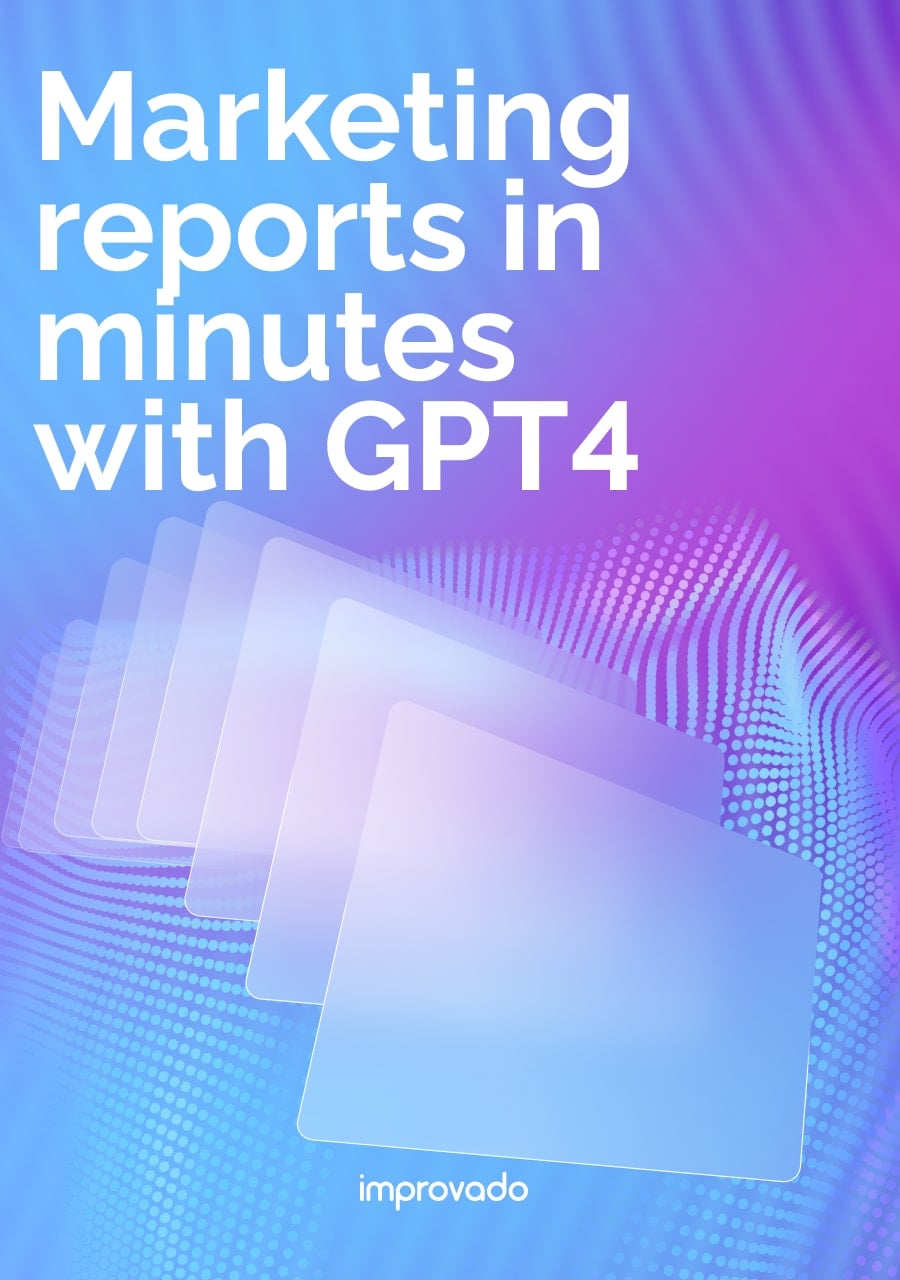If you’ve run into limitations with Klipfolio, you’re not alone.
While the platform works well for smaller datasets and straightforward dashboards, many teams begin to encounter challenges as their analytics needs grow. Common issues include integration gaps with certain marketing or revenue platforms and fewer charting and visualization options compared to dedicated BI tools.
In this article, we’ll explore 13 top Klipfolio alternatives, ranging from lightweight, general-purpose BI tools to full-scale enterprise marketing analytics platforms. These options cover a spectrum of needs, whether you’re looking for deeper customization, more robust data modeling, or advanced features.
Key Takeaways
- Klipfolio is a good starting point for basic dashboards, but it has limitations in integration depth, scalability, advanced visualizations, and governance, making it less suitable for growing or complex organizations.
- For general business intelligence needs, tools like Power BI and Tableau offer deeper analytics, advanced modeling, and cross-departmental reporting capabilities.
- Marketing agencies managing multiple clients benefit most from platforms like Whatagraph, AgencyAnalytics, or DashThis, which focus on white-label reports and streamlined client communication.
- Enterprises with complex data environments should consider Improvado for its end-to-end marketing analytics, 500+ integrations, AI-driven insights, and strong governance features.
What Is Klipfolio?
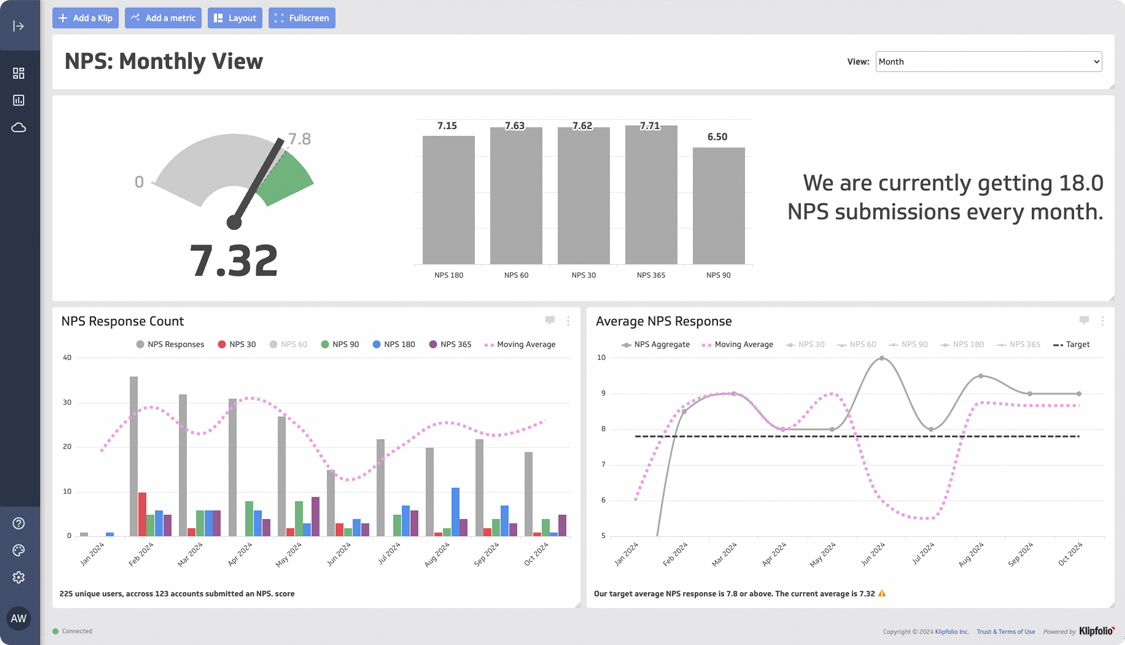
Klipfolio is a cloud-based dashboard and reporting tool designed for building and sharing business performance metrics. It connects to various data sources, allowing users to create visualizations, track KPIs, and monitor trends in real time.
The platform offers pre-built connectors, basic data transformation features, and customizable dashboards, making it suitable for teams looking for a straightforward way to consolidate and view their data in one place.
Why Look for Alternatives to Klipfolio?
While Klipfolio is a solid starting point for building simple dashboards, many organizations eventually encounter limitations as their data needs grow. These challenges often prompt teams to explore more scalable and advanced analytics solutions.
The most common reasons for seeking an alternative include:
- Limited integration depth: Klipfolio offers a variety of connectors, but many integrations lack depth or require custom workarounds. For teams managing complex, multi-channel marketing and sales ecosystems, this creates gaps in reporting and increases manual effort to keep pipelines running smoothly.
- Scalability and performance issues: The platform works well with small datasets, but performance degrades as data volumes grow or queries become more complex. Users often report slow refresh times, dashboard timeouts, and system lag when working with high-volume or detailed datasets.
- Basic visualization and customization options: Klipfolio provides core charts and widgets but lacks the advanced visualization features of dedicated BI tools like Tableau or Power BI. This limits customization for executive dashboards, stakeholder-specific reports, and complex data storytelling.
- Limited governance and security controls: As analytics programs mature, organizations need enterprise-grade governance features such as role-based access control, audit logs, and versioning. Klipfolio’s capabilities in this area are limited, making it harder to manage permissions and maintain compliance.
- Lack of advanced analytics and modeling: Teams looking to implement advanced analytics, such as predictive modeling, attribution, or real-time anomaly detection, often find Klipfolio too restrictive. These capabilities typically require deeper data modeling and transformation features than the platform supports.
At a Glance: Comparison of Top Klipfolio Alternatives
Here’s a quick overview of Klipfolio and its leading alternatives, highlighting what each tool is best suited for and its key strength. This table serves as a reference guide, with more detailed descriptions of each platform provided in the following sections.
| Tool | Best For | Key Strength |
|---|---|---|
| Klipfolio | Small to mid-sized teams needing simple dashboards | Lightweight, easy-to-use dashboarding for basic reporting |
| Improvado | Enterprises managing complex marketing data stacks | End-to-end marketing analytics with 500+ integrations and AI-driven insights |
| Domo | Companies seeking an all-in-one BI and collaboration platform | Integrated environment for data ingestion, transformation, and visualization |
| Marketing Cloud Intelligence | Organizations using Salesforce and needing deep marketing attribution | Advanced marketing analytics and tight Salesforce ecosystem integration |
| Whatagraph | Agencies managing multiple clients | Automated, white-label client reporting with ready-made templates |
| AgencyAnalytics | Agencies focused on branded, client-friendly dashboards | White-label reporting with multi-account management and portals |
| DashThis | Small teams or agencies needing simple, quick reporting | Fast setup with automated reporting and clean, easy-to-read dashboards |
| Power BI | Organizations needing general BI with advanced modeling | Deep data modeling and robust visualization within the Microsoft ecosystem |
| Tableau | Enterprises focused on visual analytics and interactive dashboards | Extensive visualization options and strong interactive exploration |
| Looker | Enterprises prioritizing governed analytics and metric standardization | Centralized semantic layer (LookML) for consistent, trusted reporting |
| Windsor.ai | Teams needing quick, easy marketing data integration | Fast setup and automated attribution for cross-channel reporting |
| Databox | Small businesses and agencies seeking mobile-friendly reporting | Easy-to-use, automated dashboards with a polished mobile app |
| Funnel.io | Teams focused on scalable data pipelines and transformation | Automated data collection and normalization for downstream analytics |
| Supermetrics | Small teams automating marketing data exports to sheets or BI tools | Simple, fast data extraction with wide connector coverage |
Best Klipfolio Alternatives for Enterprise-Grade Reporting
These Klipfolio alternatives are designed for companies managing complex data stacks and large volumes of marketing, sales, and operational data.
Unlike lightweight dashboard tools, they offer advanced integrations, robust governance, and scalability to support enterprise-level reporting, analytics, and decision-making.
1. Improvado
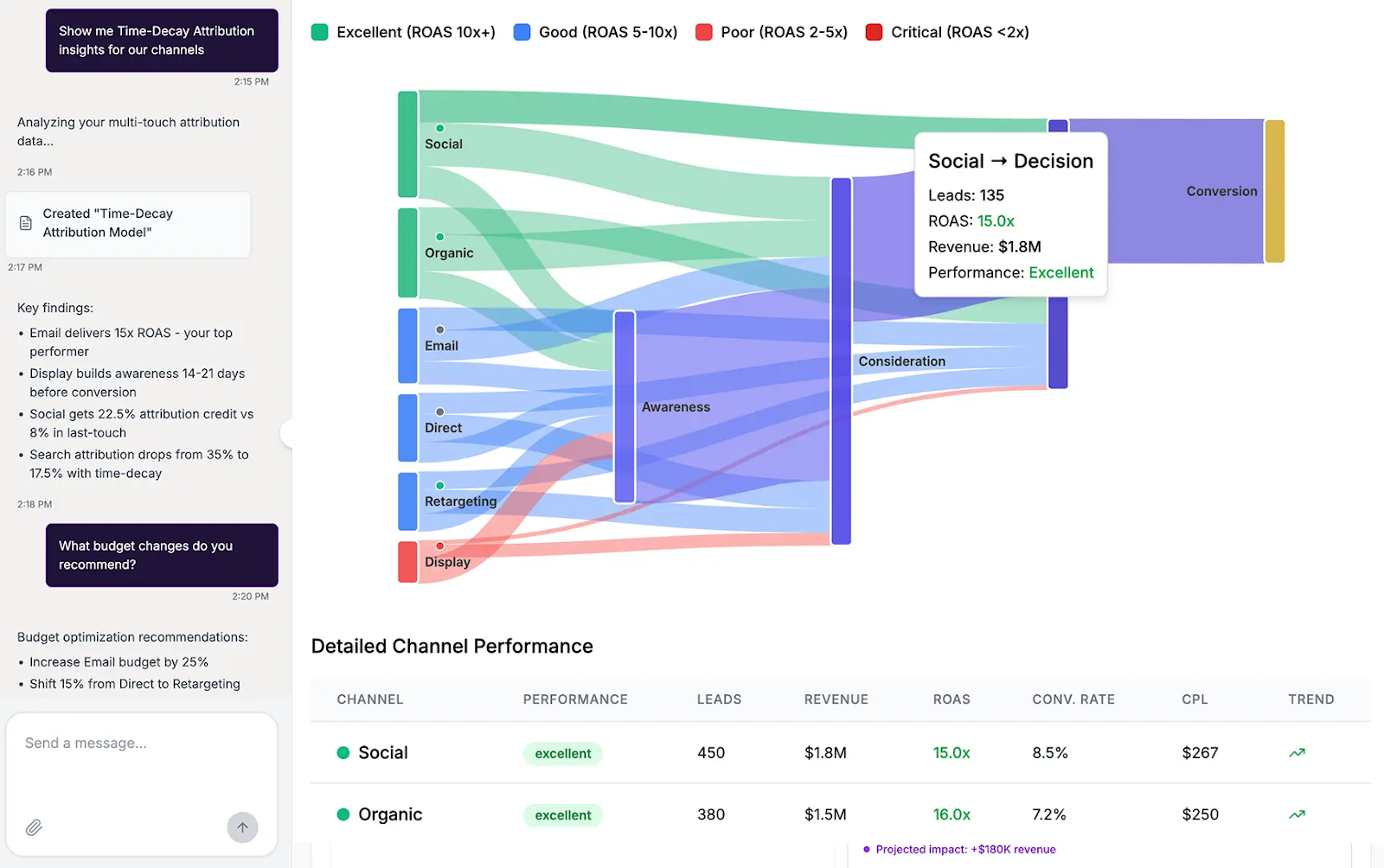
Improvado is an end-to-end marketing analytics platform designed for companies with complex data environments and strict governance requirements.
Unlike dashboard-only tools, Improvado focuses on automating the entire data lifecycle — from aggregating data from over 500 sources to normalizing, modeling, and preparing it for advanced analytics, BI reporting, and activation.
It also includes an AI Agent that delivers instant insights through natural language queries, significantly reducing the time from question to decision.
Pros
- Extensive integrations: Supports 500+ marketing, sales, and revenue platforms, providing automated ingestion and normalization to create a single source of truth without manual exports or fragile custom connectors.
- Built-in governance: Enforces naming conventions, validates data quality, deduplicates records, and applies compliance policies to ensure accuracy and reliability across global teams.
- AI-powered insights: The Improvado AI Agent helps users query data in plain language, build dashboards, and surface optimization recommendations instantly — no SQL or data science background required.
- Custom metrics and transformations: Offers robust modeling and transformation capabilities that let teams create tailored KPIs and blend data across platforms without any coding or external ETL tools.
- Enterprise-grade scalability: Designed to handle high data volumes and complex multi-brand, multi-client, or multi-region structures while maintaining speed and stability.
- Advanced security and compliance: Features include role-based access control, PII masking, SOC 2 certification, and audit logging to meet regulatory standards.
- BI enablement: Seamlessly integrates with BI tools like Tableau, Power BI, and Looker while also providing dashboard templates and generative dashboards for quick, ad hoc analysis.
- Reduced IT dependency: Automation significantly lowers engineering overhead, allowing marketing and analytics teams to operate independently and focus on insights rather than pipeline maintenance.
Cons
- Implementation time: Initial setup and configuration require proper planning, especially for organizations without established data governance processes.
- Learning curve: While designed for non-technical users, advanced features and governance controls may require onboarding for optimal use.
- Best fit for complex environments: Smaller teams or those with basic reporting needs may find its capabilities exceed their requirements.
Improvado Pricing
Improvado offers tiered pricing models based on data volume, number of integrations, and customization needs.
- Plans range from growth-focused packages for scaling teams to enterprise-level solutions with advanced governance and compliance features.
- All plans include access to the full library of 500+ connectors with an unlimited number of accounts, core automation capabilities, and customization credits.
- Pricing is customized for each organization, ensuring alignment with data volume, integration complexity, and required SLAs.
2. Domo

Domo is a cloud-based business intelligence and analytics platform. It offers a wide range of connectors, data transformation tools, and collaborative features aimed at providing a single environment for reporting and decision-making.
Domo is often chosen by companies looking for a more scalable and visually polished alternative to lightweight dashboard tools like Klipfolio.
Pros
- Wide connector library: Supports hundreds of data sources, including marketing, sales, finance, and operational platforms.
- End-to-end platform: Handles ingestion, transformation, storage, and visualization within one system, reducing the need for multiple tools.
- Collaboration features: Built-in sharing, alerts, and commenting help teams align around real-time data and decisions.
- Customizable dashboards: Offers more advanced visualization options than basic tools, with a variety of chart types and layout flexibility.
- Scalability: Can handle larger datasets and more complex reporting compared to Klipfolio.
Cons
- Setup and configuration can be time-intensive, especially for complex data environments.
- May require technical expertise for advanced data modeling or transformations.
- Pricing can be higher than some alternatives, making it less ideal for smaller organizations.
Domo Pricing
Domo doesn't disclose any pricing details on the website, only stating that the price depends on the usage of the platform and parameters like data storage, data refresh rates, the volume of data queries, and the number of users.
3. Marketing Cloud Intelligence (formerly Datorama)
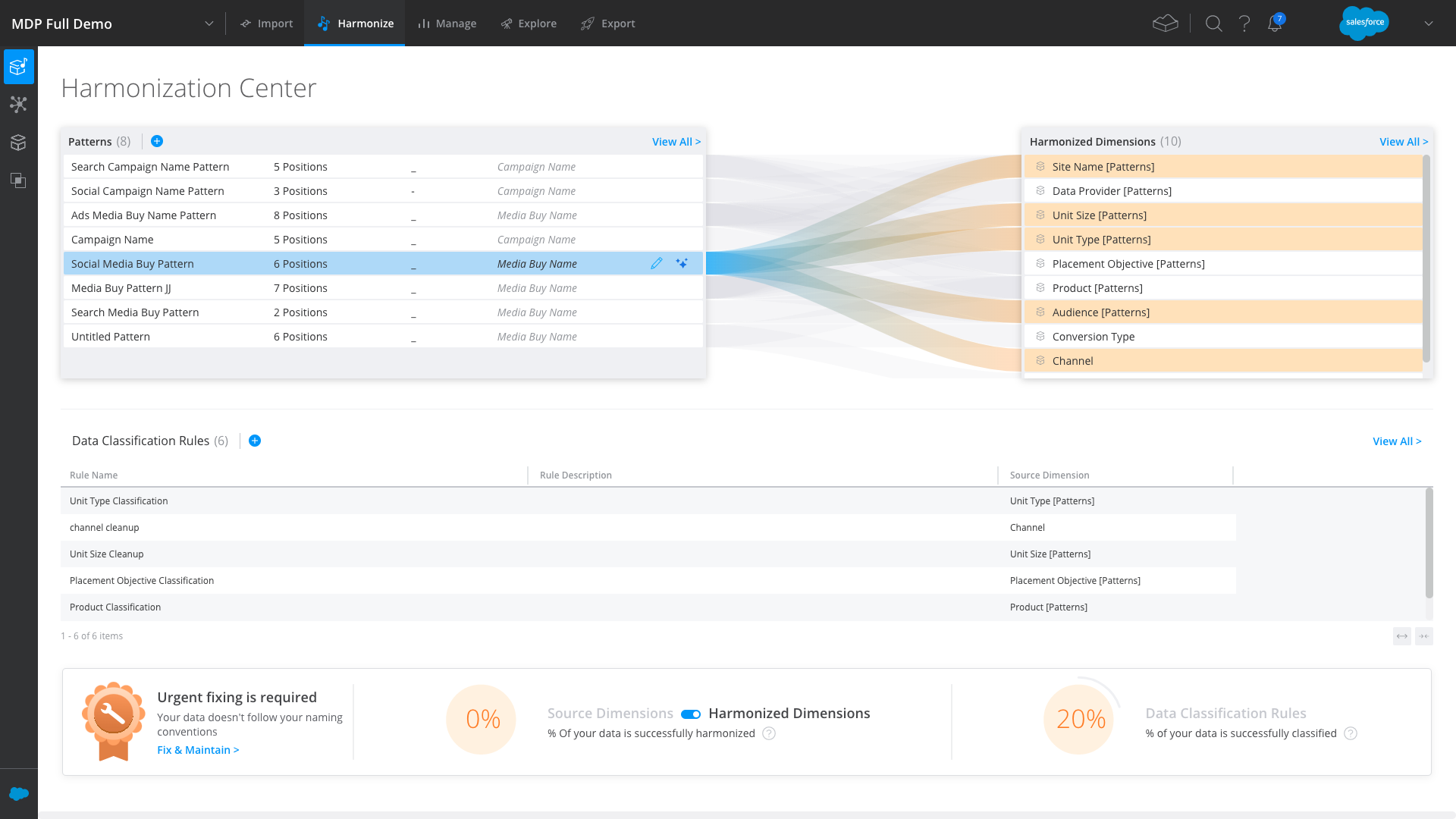
Marketing Cloud Intelligence, previously known as Datorama, is Salesforce’s enterprise marketing analytics solution designed for organizations managing complex, multi-channel marketing ecosystems.
It centralizes data from various sources into a single environment, providing advanced visualization, reporting, and optimization tools. With deep native Salesforce integrations, it is especially well-suited for companies already using Salesforce products and seeking a tightly integrated marketing analytics platform.
Pros
- Strong marketing focus: Built specifically for marketing data, offering pre-built connectors and templates for ad platforms, CRMs, and campaign management tools.
- Deep Salesforce integration: Seamlessly connects with Salesforce Marketing Cloud, Sales Cloud, and other Salesforce products.
- Customizable reporting and dashboards: Flexible visualization options tailored to marketing KPIs and cross-channel performance tracking.
- Advanced attribution and analytics: Supports multi-touch attribution, data blending, and optimization for budget allocation and campaign performance.
- Data governance and compliance: Enterprise-grade security with access controls and audit capabilities to meet compliance needs.
Cons
- Steeper learning curve compared to lighter tools due to advanced functionality and complexity.
- Setup and ongoing management require technical expertise and Salesforce administration knowledge.
- Pricing can be high, especially for organizations not already in the Salesforce ecosystem.
Marketing Cloud Intelligence Pricing
Marketing Cloud Intelligence offers tiered, subscription-based pricing aligned with data volume, number of users, and feature sets.
- Plans start from $3,000 a month, with costs increasing significantly for high data volumes and advanced capabilities.
- Best suited for mid-sized to large organizations with mature marketing operations and the resources to support ongoing management.
Best Klipfolio Alternatives for Marketing Agencies
The platforms in this category are tailored for marketing agencies that manage multiple clients and need to deliver clear, professional reports at scale.
They focus on features like white-label dashboards, automated report scheduling, and multi-account management, making it easier for agencies to streamline reporting, improve client communication, and reduce the manual work involved in cross-channel performance tracking.
4. Whatagraph
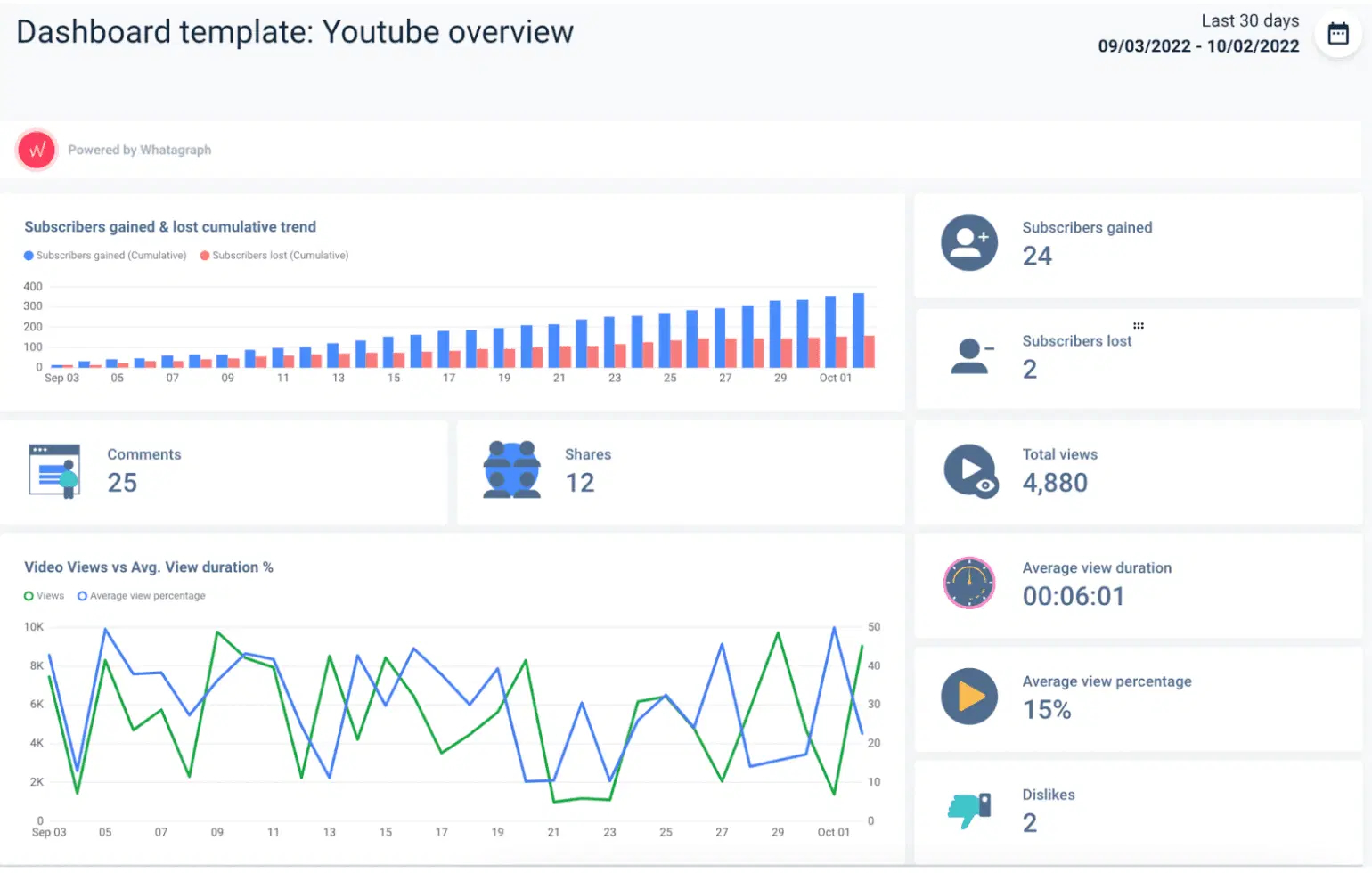
Whatagraph is a marketing reporting and automation platform designed primarily for agencies and teams managing multiple client accounts. It focuses on simplifying cross-channel reporting by automating data collection, visualization, and delivery of client-ready reports. With its streamlined setup and client-friendly interface, Whatagraph is a strong alternative to Klipfolio for agencies seeking to scale reporting without heavy technical overhead.
Pros
- Agency-focused design: Built specifically for marketing agencies managing many clients, offering multi-account management and white-label reporting.
- Automated reporting: Automatically pulls data from popular marketing and advertising platforms, reducing manual reporting work.
- Client-ready templates: Pre-built, easy-to-customize templates tailored for marketing KPIs, making it quick to deliver polished reports.
- Simple setup and usability: Easy to get started without deep technical knowledge or complex configuration.
- Scheduled reports: Supports recurring, automated report delivery directly to clients.
Cons
- Limited data transformation and modeling features compared to full-scale BI platforms.
- Fewer governance and compliance capabilities for enterprises with strict data policies.
- May not scale well for highly complex datasets or advanced analytics needs.
Whatagraph Pricing
Whatagraph does not disclose its pricing on the website.
5. AgencyAnalytics
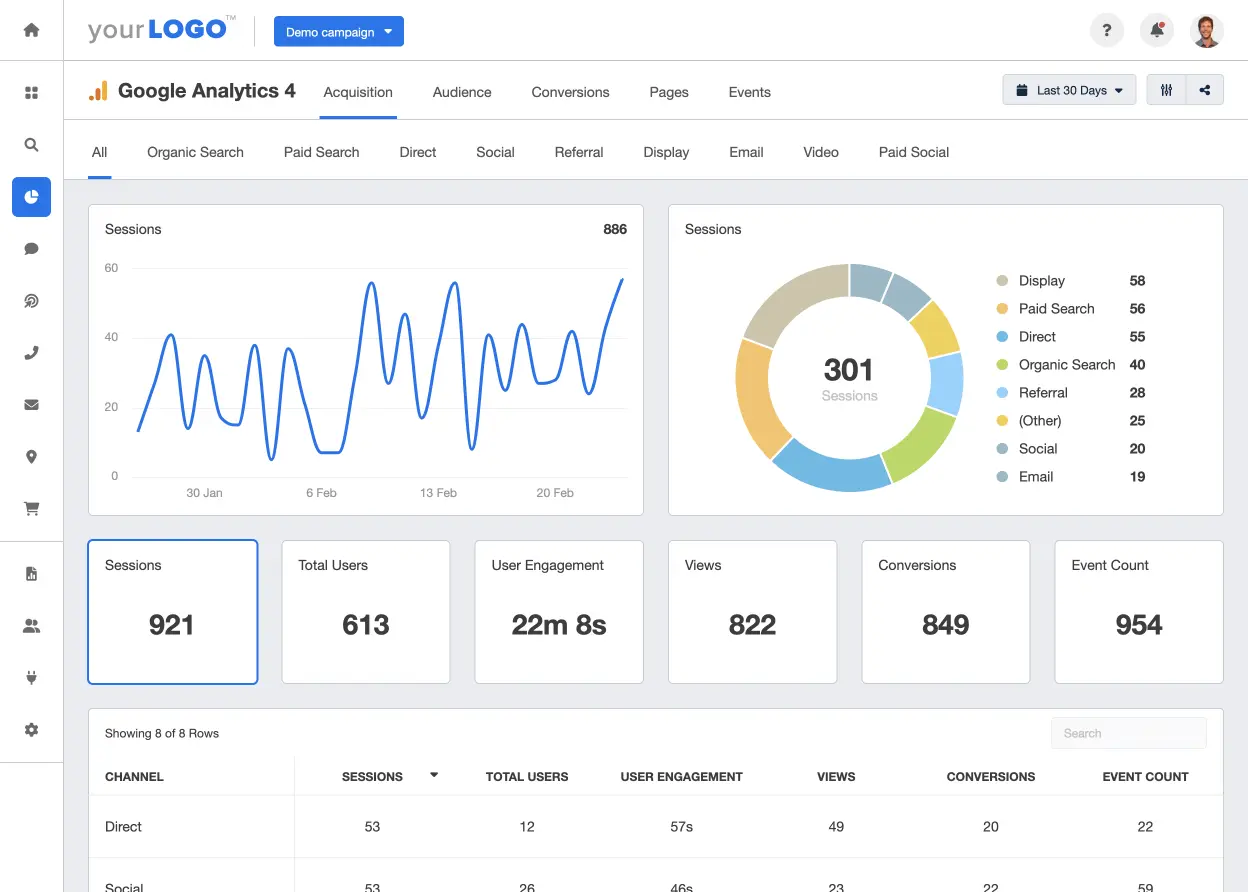
AgencyAnalytics is a reporting and analytics platform designed specifically for digital marketing agencies. It focuses on helping agencies manage multiple client accounts efficiently by automating data collection, dashboard creation, and performance reporting.
With its agency-focused features like white-labeling, team management, and client portals, it serves as a strong alternative to Klipfolio for agencies seeking a streamlined, client-friendly reporting solution.
Pros
- Purpose-built for agencies: Includes tools for managing multiple clients, team members, and accounts within a single platform.
- White-label dashboards and reports: Agencies can fully brand dashboards and reports to deliver a seamless client experience.
- Wide range of marketing integrations: Supports 80+ popular platforms, including Google Ads, Facebook Ads, SEO tools, and CRMs.
- Client portals and permissions: Provides secure, dedicated client logins with customizable access levels.
- Automated reporting: Enables scheduled reporting to reduce manual work and ensure consistent client updates.
- Ease of use: Designed for quick setup and minimal technical overhead, ideal for teams without dedicated data engineers.
Cons
- Limited advanced data modeling and transformation capabilities compared to enterprise BI platforms.
- Fewer governance and compliance controls for organizations with strict data security requirements.
- May not support highly complex, cross-channel data blending or custom metrics at scale.
AgencyAnalytics Pricing
AgencyAnalytics uses tiered, subscription-based pricing that scales based on the number of clients and features needed. Lower entry cost makes it accessible for smaller agencies or teams just starting out.
6. DashThis
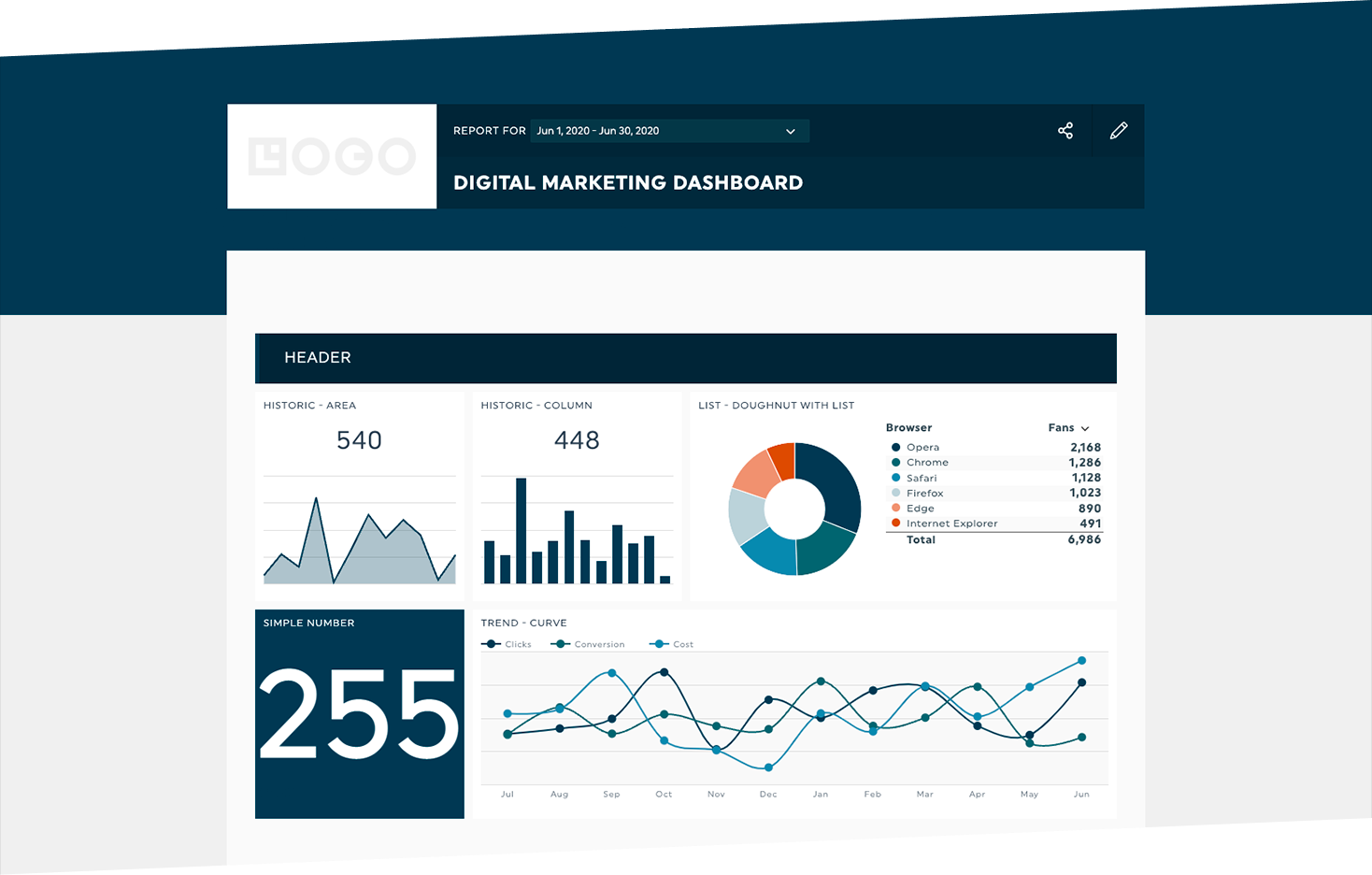
DashThis is a marketing reporting tool designed to simplify the process of creating and sharing performance dashboards. It focuses on helping agencies and marketing teams quickly consolidate data from multiple platforms into easy-to-read reports without requiring complex configuration or technical expertise.
As a Klipfolio alternative, DashThis appeals to organizations seeking straightforward, automated reporting for common marketing metrics and campaigns.
Pros
- Quick setup and simplicity: Easy to implement with minimal technical skills required, making it ideal for small teams and agencies.
- Pre-built templates: Offers ready-to-use templates for common marketing KPIs, reducing setup time and ensuring consistency across reports.
- Automated data pulls: Connects to popular marketing platforms like Google Ads, Facebook Ads, and HubSpot to automatically update reports.
- Client-friendly reporting: Generates clear, visually clean dashboards that are easy for clients to understand.
- Scheduled delivery: Supports automatic report distribution to clients or stakeholders on a recurring schedule.
- Affordable for smaller teams: Lower starting cost compared to enterprise BI platforms.
Cons
- Limited data transformation and blending capabilities for more complex reporting needs.
- Fewer integrations compared to enterprise tools like Improvado or Domo.
- Lack of advanced governance, role-based permissions, or compliance features required by larger organizations.
- May not handle large-scale datasets or highly customized analytics well.
DashThis Pricing
DashThis offers tiered pricing based on the number of dashboards and client accounts managed. Professional plans start from $135 a month.
A free trial is available for agencies to test the platform’s setup and reporting features before committing.
Best Klipfolio Alternatives for General Business Intelligence (BI)
These Klipfolio competitors are designed for organizations that need a broader, company-wide analytics solution. They go beyond marketing dashboards to support advanced data modeling, interactive exploration, and cross-departmental reporting.
7. Microsoft Power BI
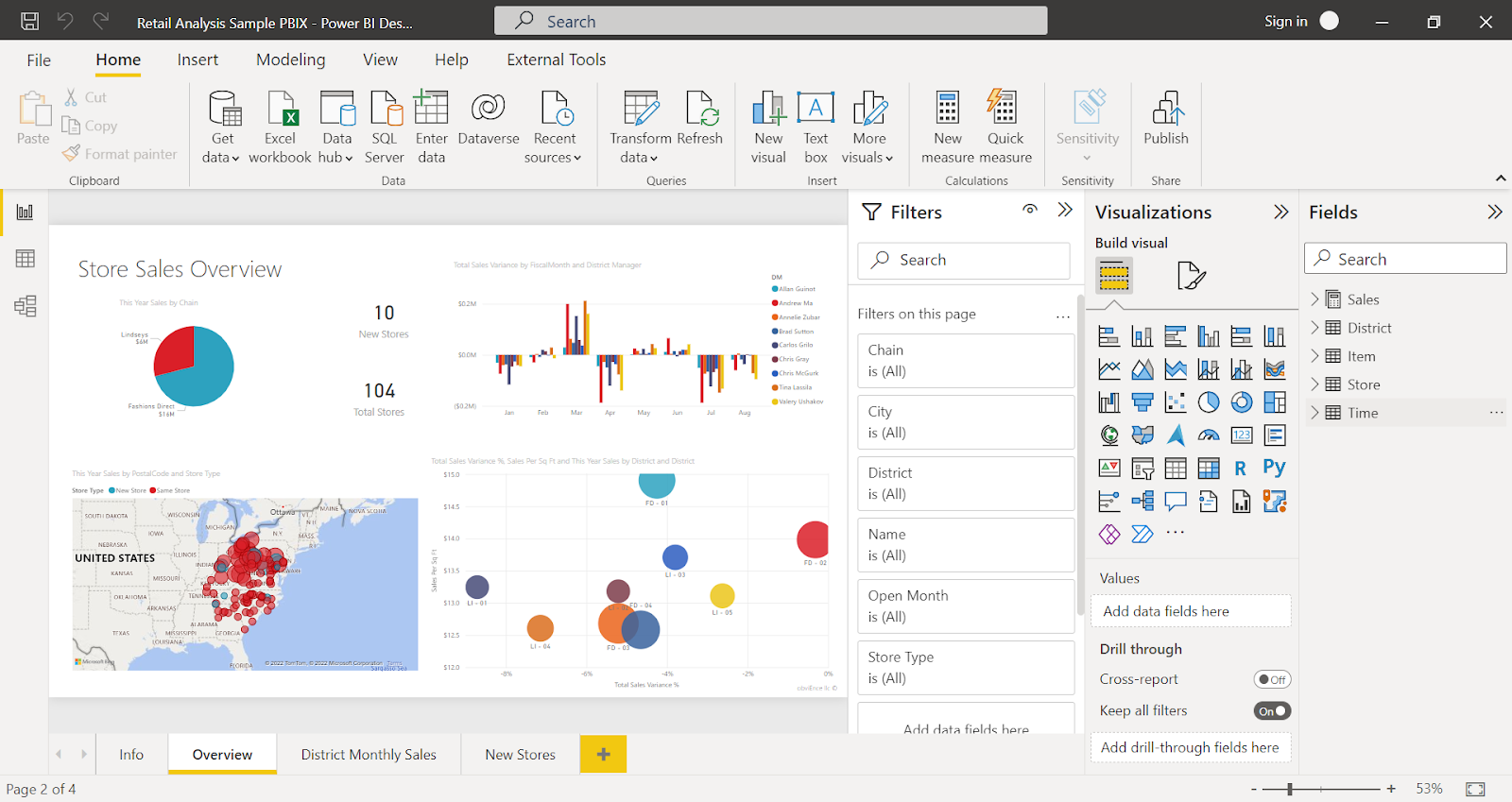
Power BI is Microsoft’s flagship business intelligence (BI) platform, designed to handle data visualization, analytics, and reporting at scale.
Unlike Klipfolio, which focuses primarily on lightweight marketing dashboards, Power BI provides a comprehensive set of tools for data modeling, interactive exploration, and advanced analytics across all business functions. It integrates deeply with the Microsoft ecosystem, making it a strong choice for organizations that already use Azure, Excel, or other Microsoft services.
Pros
- Advanced data modeling: Supports complex relationships, transformations, and calculations using DAX and Power Query, enabling deeper analytics than basic dashboard tools.
- Wide range of visualizations: Offers a large library of built-in and custom visuals for highly tailored reporting and data storytelling.
- Seamless Microsoft integration: Natively integrates with Excel, Azure, Dynamics, and other Microsoft tools for streamlined workflows.
- Scalability: Handles large datasets and complex queries, making it suitable for enterprise-scale reporting.
- Robust security and governance: Features like role-based access control, data sensitivity labels, and compliance management support enterprise data governance needs.
- Cost-effective entry point: Offers a free desktop version and affordable licensing options for small teams and individual users.
Cons
- Steeper learning curve, especially for teams without experience in data modeling or BI tools.
- Requires dedicated resources or technical expertise to manage data sources and create complex dashboards.
- Not specialized for marketing reporting, may need additional setup or third-party connectors for marketing data integration.
Power BI Pricing
Power BI offers flexible licensing options to support a range of use cases:
- Power BI Desktop: Free version for individual users to create reports and visualizations.
- Power BI Pro: Monthly per-user subscription with sharing and collaboration capabilities.
- Power BI Premium: Provides dedicated cloud resources, advanced governance, and enterprise-scale performance.
Pricing scales based on the number of users, data capacity, and required features.
8. Tableau

Tableau is one of the leading business intelligence and data visualization platforms designed for organizations that require advanced analytics and highly customizable dashboards.
Unlike Klipfolio, which focuses on lightweight marketing dashboards, Tableau provides robust capabilities for interactive exploration, complex data modeling, and deep analytics across multiple business domains.
Pros
- Rich visualization options: Offers one of the most extensive libraries of charts and interactive visual elements, ideal for data storytelling and executive-level reporting.
- Interactive exploration: Allows users to drill down into data, uncover trends, and create dynamic dashboards that update in real time.
- Strong data connectivity: Connects to a wide variety of data sources, including cloud warehouses, on-premises databases, and marketing platforms.
- Advanced analytics features: Supports statistical modeling, forecasting, and data blending for more sophisticated analyses.
- Scalability: Handles large and complex datasets, making it suitable for enterprise-level reporting needs.
- Collaboration tools: Tableau Server and Tableau Cloud enable secure sharing, permissions management, and cross-team collaboration.
Cons
- Steep learning curve for new users, especially when building advanced dashboards or models.
- Requires more technical expertise and planning compared to lightweight tools like Klipfolio.
- Higher licensing costs, particularly for enterprise-scale deployments.
- Marketing-specific features are limited without custom setups or third-party connectors.
Tableau Pricing
Tableau offers several licensing tiers based on user roles and deployment needs:
- Tableau Viewer: For users who primarily view and interact with dashboards.
- Tableau Explorer: For users who need some self-service reporting and dashboard creation capabilities.
- Tableau Creator: Full access for building and modeling data from scratch.
Pricing varies by tier and whether it is deployed via Tableau Cloud (hosted) or Tableau Server (self-hosted).
9. Looker (Google Cloud)
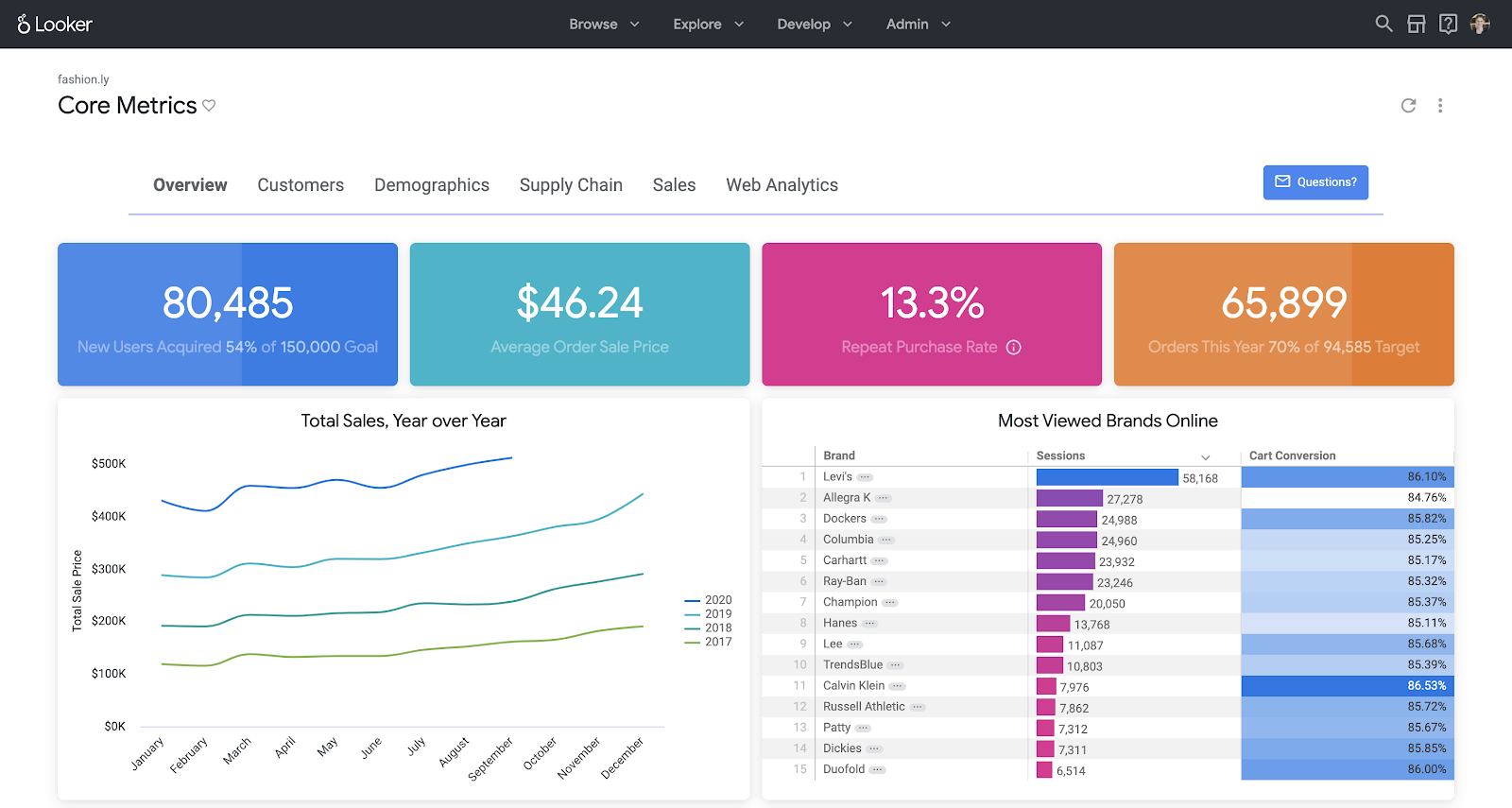
Looker is a modern business intelligence and data exploration platform known for its semantic modeling layer, LookML, which allows organizations to define consistent metrics and business logic across teams.
Looker is a strong Klipfolio alternative for enterprises that prioritize centralized data definitions, governed analytics, and seamless integration with cloud data infrastructure. It excels at delivering trusted, consistent insights across complex organizations, making it ideal for companies looking to standardize analytics at scale.
Pros
- Semantic modeling with LookML: Creates a centralized source of truth for metrics and definitions, reducing discrepancies across teams and reports.
- Strong governance capabilities: Enforces access controls, versioning, and compliance to maintain data integrity and security at scale.
- Cloud-native architecture: Optimized for cloud warehouses like BigQuery, Snowflake, and Redshift for high-performance analytics.
- Flexible integrations: Connects with a wide variety of data sources and embeds analytics directly into applications or customer-facing products.
- Self-service analytics: Empowers business users to explore and build reports without heavy reliance on data engineering teams.
- Customizable dashboards: Offers interactive and dynamic visualizations tailored to different stakeholders.
Cons
- Steeper learning curve due to the need to learn LookML for modeling and metric definitions.
- Requires strong initial setup and ongoing maintenance to manage governance and semantic layers.
- Higher cost compared to lightweight reporting platforms, making it more suitable for mid-market and enterprise organizations.
Looker Pricing
Looker uses a custom, quote-based pricing model tailored to each organization’s scale and requirements.
Best Klipfolio Alternatives for Data Integration and Ease of Use
These alternatives are ideal for teams that need to streamline the process of collecting, cleaning, and centralizing marketing data without heavy engineering resources. Unlike platforms focused solely on visualization, these tools prioritize automated integrations, flexible data exports, and ease of setup.
10. Windsor.ai

Windsor.ai is a marketing data integration and analytics platform built to simplify the process of unifying marketing, sales, and revenue data. It focuses on automating data collection and blending across channels.
Windsor.ai is a strong Klipfolio alternative for teams seeking a lightweight yet powerful solution to connect data without heavy engineering resources.
Pros
- Quick setup and onboarding: Designed for speed and simplicity, allowing teams to start integrating data in minutes without complex configuration.
- Extensive marketing connectors: Supports a wide range of ad, analytics, and CRM platforms, ensuring comprehensive coverage for cross-channel reporting.
- Flexible output options: Can send normalized data directly to BI tools like Power BI and Tableau, cloud data warehouses such as BigQuery and Snowflake, or back to marketing platforms for activation.
- Automated attribution modeling: Built-in multi-touch attribution models help teams evaluate campaign performance across channels.
- User-friendly interface: Simplifies data integration tasks, making it accessible to marketers and analysts without technical expertise.
- Cost-efficient solution: Offers a lower entry cost compared to enterprise-scale data integration tools.
Cons
- Limited governance and compliance features for large enterprises with strict regulatory requirements.
- Fewer advanced data transformation capabilities compared to more comprehensive ETL solutions.
- May not scale as well for very high data volumes or highly complex, multi-brand environments.
Windsor.ai Pricing
Windsor.ai offers subscription-based pricing with plans that scale by data volume, number of connectors, and level of support required. Plans start at $19 a month.
11. Databox
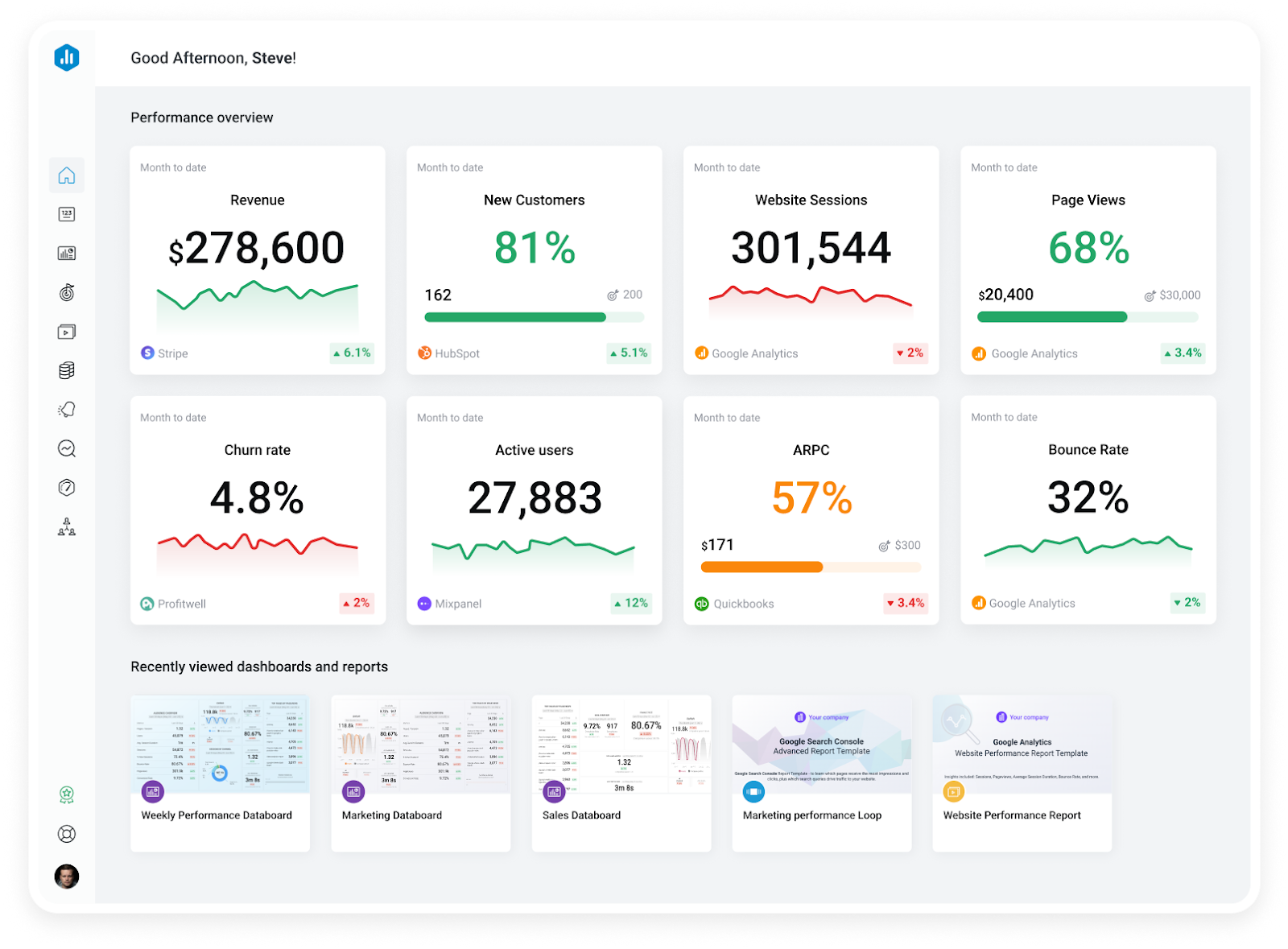
Databox is a cloud-based reporting and analytics platform.
Databox is ideal for marketing teams and agencies seeking a straightforward, visually appealing reporting solution with minimal setup. While it lacks the depth and governance of enterprise-grade platforms, its automation, mobile experience, and ease of use make it a strong alternative to Klipfolio for lightweight, real-time performance tracking.
Pros
- Easy setup: Quick to implement with minimal technical skills required, making it accessible for small teams and agencies.
- Pre-built templates and dashboards: Offers ready-made visualizations for common KPIs, reducing the time needed to build reports from scratch.
- Automated reporting: Pulls data automatically from popular marketing, sales, and analytics platforms, eliminating the need for manual updates.
- Mobile-first experience: Provides a polished mobile app for real-time performance tracking on the go.
- Client-friendly reporting: Simplifies sharing reports with clients or stakeholders, with visually clear and easy-to-read dashboards.
- Affordable entry point: Lower starting price compared to enterprise BI platforms, ideal for smaller teams.
Cons
- Limited data transformation and blending capabilities for more complex reporting requirements.
- Governance and compliance controls are minimal, making it less suitable for enterprises with strict data policies.
- Fewer customization options compared to advanced BI tools like Tableau or Power BI.
- May not scale well for organizations with high data volumes or advanced analytics needs.
Databox Pricing
Databox offers tiered, subscription-based pricing based on the number of data sources, dashboards, and features needed.
Entry-level plans are affordable for small teams or agencies just starting with analytics. Higher tiers include additional integrations, white-label options, and more advanced reporting features.
12. Funnel.io
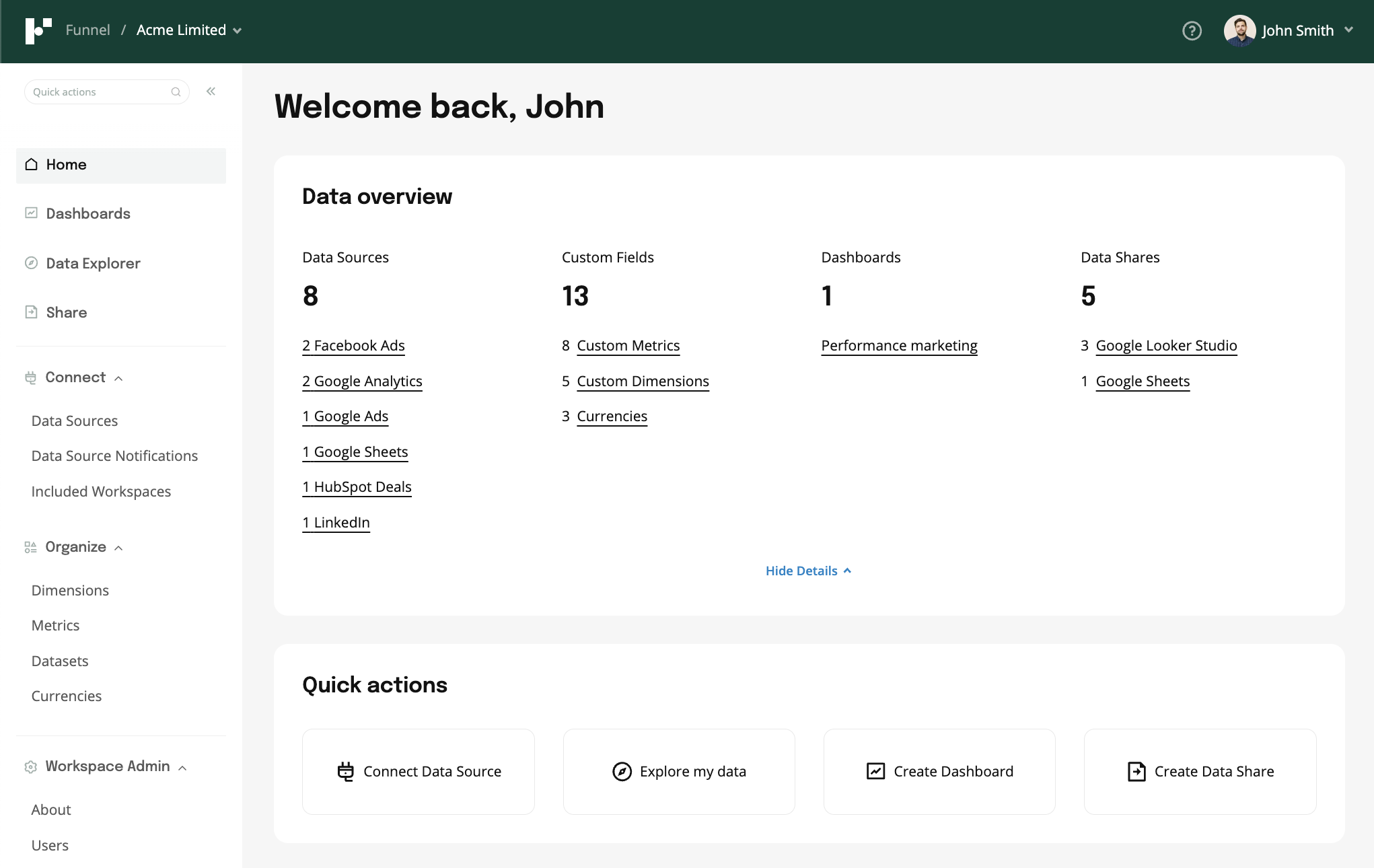
Funnel.io is a marketing data integration and analytics platform. As a Klipfolio alternative, Funnel.io is ideal for teams that need reliable, automated data pipelines rather than just dashboard visualization.
Pros
- Extensive marketing integrations: Supports hundreds of advertising, analytics, and CRM platforms, making it easy to unify cross-channel marketing data.
- Automated data transformation: Cleans and standardizes data automatically, reducing manual work and ensuring consistent taxonomies across all sources.
- Flexible data export options: Pushes data into BI tools like Power BI and Tableau, cloud warehouses like Snowflake or BigQuery, or back into operational systems.
- Strong data ownership model: Keeps raw and transformed data accessible, giving teams full control over their data workflows.
- No-code interface: Simplifies setup and management, enabling marketers and analysts to work without heavy engineering support.
Cons
- Limited advanced analytics and modeling compared to end-to-end marketing analytics platforms.
- Pricing can become high as the number of data sources and volume of data increase.
- Governance and compliance controls are less comprehensive than in enterprise-focused platforms.
Funnel.io Pricing
Funnel offers four main pricing plans tailored to different organizational needs: Free, Starter, Business, and Enterprise.
13. Supermetrics
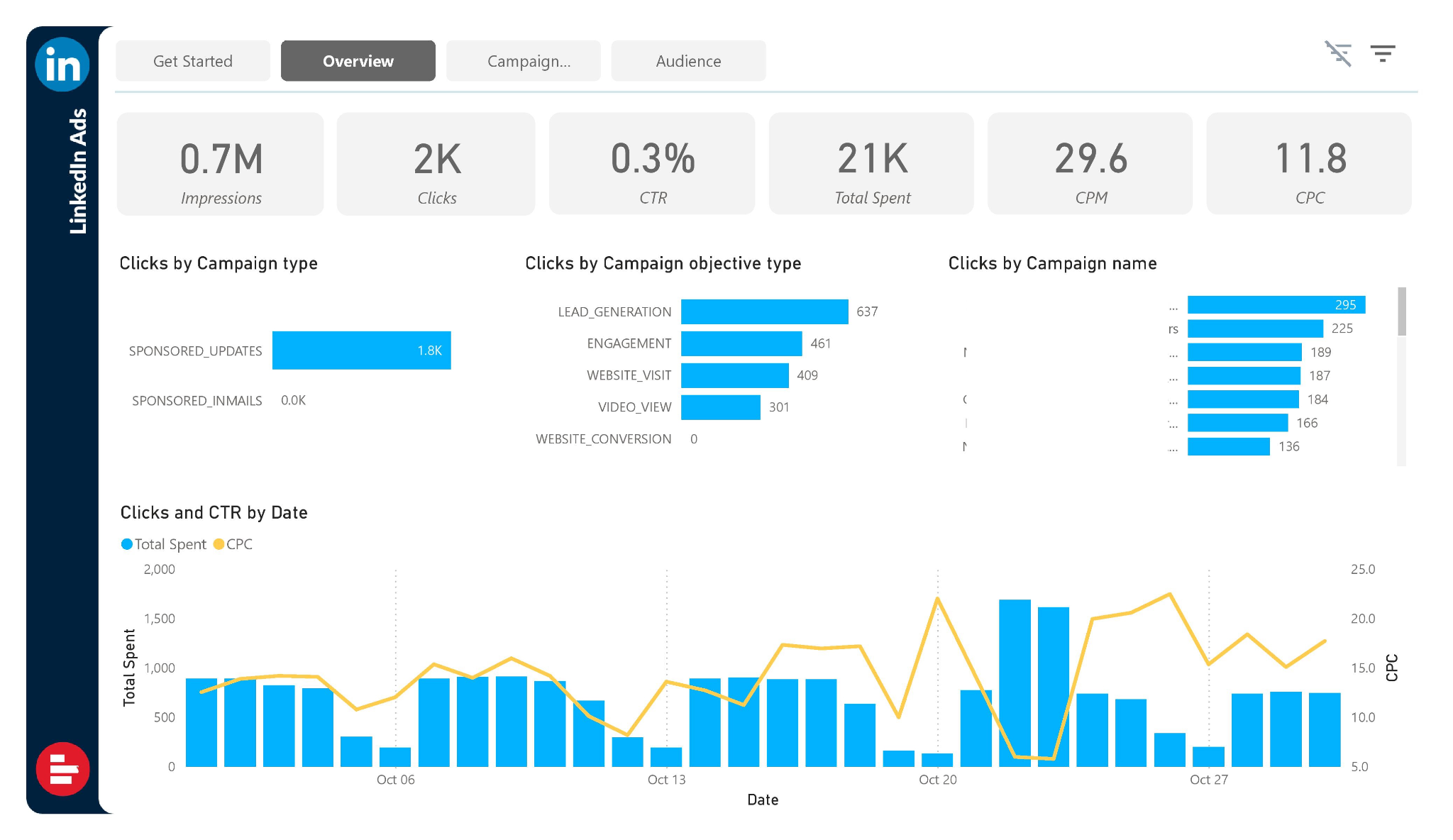
Supermetrics is a marketing data aggregation tool designed to help teams quickly collect data from various marketing and advertising platforms into analytics and reporting environments.
Supermetrics is a lightweight solution that focuses on data extraction and delivery rather than advanced transformation or visualization. As a Klipfolio alternative, it appeals to teams looking for an easy way to automate marketing data pulls into spreadsheets, BI tools, or warehouses without building complex integrations.
Pros
- Fast setup: Simple to implement with minimal technical expertise required, making it accessible for small teams and agencies.
- Connector coverage: Supports a wide range of marketing, advertising, and analytics platforms, including Google Ads, Meta Ads, LinkedIn, HubSpot, and more.
- Direct integrations: Easily connects with tools like Google Sheets, Excel, Data Studio, and cloud warehouses such as BigQuery and Snowflake.
- Cost-effective for smaller needs: Affordable solution for teams that primarily need automated data exports for basic reporting.
- Flexible reporting outputs: Lets users choose where data is sent, supporting diverse reporting workflows.
Cons
- Limited data transformation and cleaning: raw data often requires additional preparation in other tools.
- No built-in visualization or advanced analytics features; reporting must be done in external platforms.
- Scalability issues for very large datasets or complex, multi-brand environments.
- Minimal governance and compliance controls compared to enterprise-grade solutions.
Supermetrics Pricing
Supermetrics uses a tiered subscription pricing model based on the number of data sources, destinations, and users. Lower entry-level costs make it attractive for small businesses and agencies.
How to Choose the Right Alternative
The best Klipfolio alternative depends on your organization’s size, data complexity, and reporting needs.
- Agencies may prioritize white-label dashboards and client portals, making tools like Whatagraph, AgencyAnalytics, or DashThis a better fit.
- Companies looking for general BI may prefer platforms like Power BI, Tableau, or Looker for advanced visualization and cross-departmental reporting.
For companies seeking a more advanced solution with enterprise-grade governance, AI-driven insights, and 500+ integrations, Improvado is a strong choice. It centralizes data, eliminates manual processes, and scales as your needs grow.
Book a demo to see how Improvado can help transform your marketing analytics.
.png)



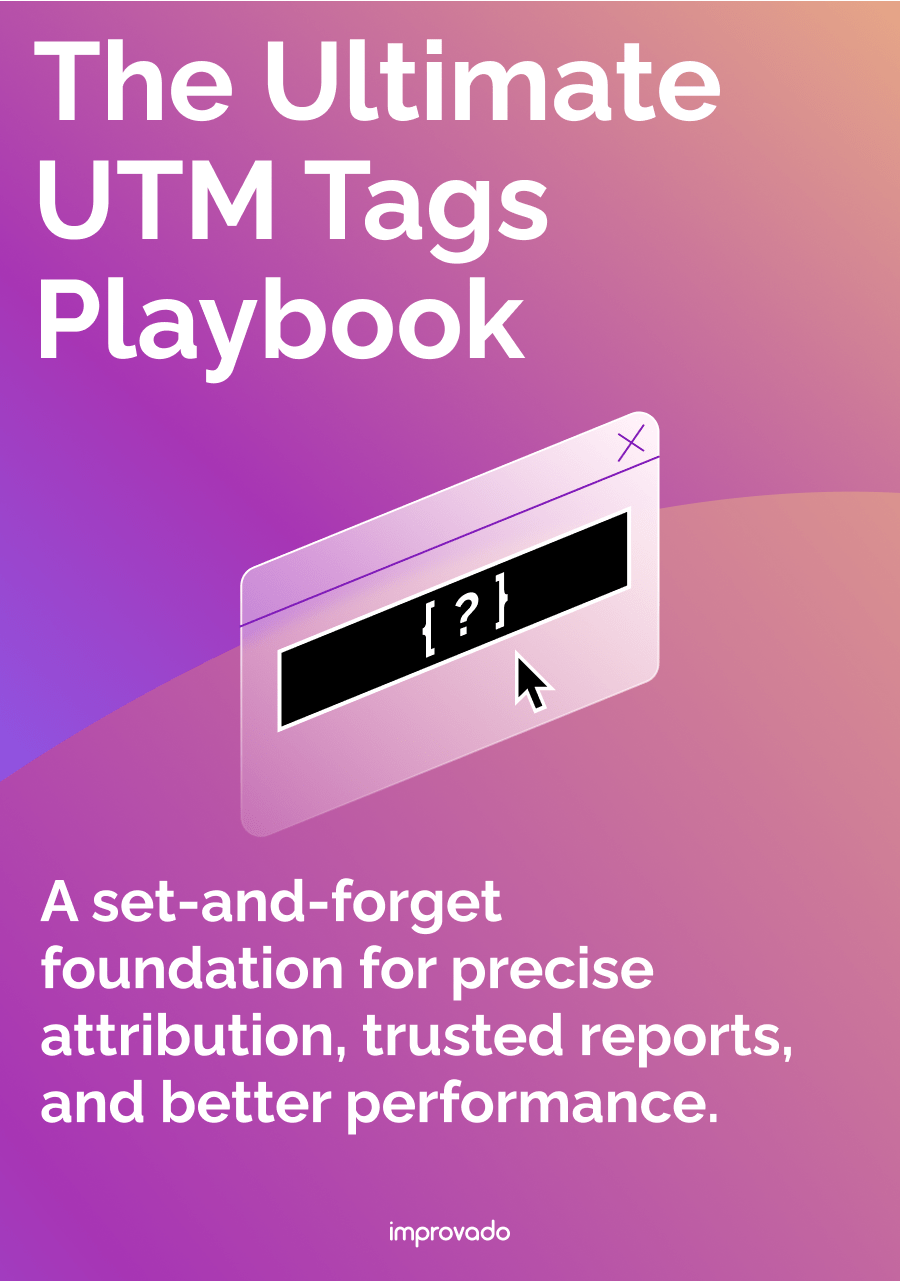
.png)
